Recently, I’ve been exploring the area around the Royal Victoria Dock, which now has lots of houses on its south side, between it and the River Thames, and the ExCeL (apologies for the correct spelling there) Centre on its north side, where they hold big exhibitions like, most recently, this.
The area abounds with photo-opportunities of the sort that I like. To the West, there is the Dome and the Docklands Towers. Beyond them, other more distant towers nearer to London’s centre can be spotted, by me anyway. To the East, interestingly obscure airplanes land and take off from the City Airport, often flying the length of the Dock in the process, near enough for me to actually see some detail in my snaps of them. All around the Dock, large but idle cranes stand, reminders of more muscular and industrial times for this stretch of water, which now advertises itself on the outsides of nearby building sites as being a venue for sporty little sailing boats.
Best of all, there is a big footbridge, half way along the Dock, north to south, with a span high into the sky which is reached by lifts at each end. The views from this bridge, especially those looking West into central London, are very fine.
And all around the Royal Victoria Dock, as everywhere else in Britain that I have visited lately, there are official signs of all sorts (a more recent photographic enthusiasm of mine), urging this, forbidding that, threatening and warning and nagging and cajoling.
Are you a building worker? Be careful in there:
Building workers seem often to get bombarded with the visual equivalent of a Fidel Castro speech, in the form of huge clumps of warnings about every imaginable infringement of safety they might choose to indulge in.
The rest of us are of course nagged on a similar scale, but each nag tends to have its own separate notice.
So, at the Royal Victoria Docks, we observe, if we choose to, dozens of nags and official imprecations of all kinds… Are you the kind of person who thinks that jet airplanes in the vicinity of airports are always silent? They are not:
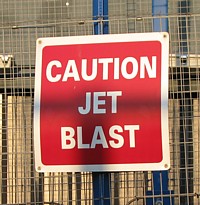
Were you thinking of doing some fishing? Think again:
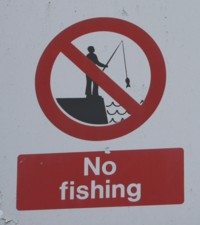
And be warned that “but I was doing it at night” will not wash as a defence:
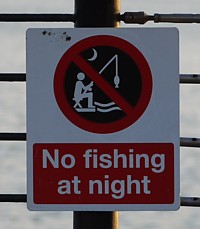
This being a big stretch of water, there are signs upon signs, too numerous to count, all saying:
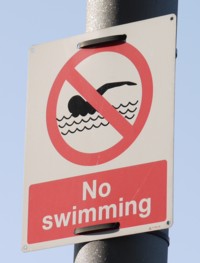
All of the above drops in the ocean of signage in and around the Royal Victoria Dock are signs that I made a point of noticing, but which others would not. But, in among all these very ignorable signs, I came across this next sign. It also concerns swimming, but I think that this is a no swimming sign with a difference:
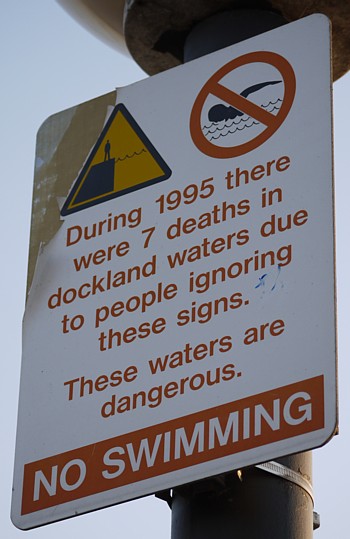
That is a sign which I think I would have noticed even if I had not been noticing signs generally at all.
It’s as if its creator was, while creating it, thinking and feeling something rather unusual. He actually cared about people reading his sign and about people doing what he said. He really wanted to communicate something.
He thought about it. How can I word it, he said to himself, to make sure that people pay attention, refrain from swimming in these truly dangerous waters, in which, I know for a fact, in 1995, no fewer than seven – seven – people were drowned? How can I get that across? Lives are at stake here. Before I die, I want to make the world a slightly better place. This is my chance.
You can see the scene in his office, in 1999 or whenever it was. “I’m stuck,” said he. Stuck? Relax, said his less committed colleagues. It’s only a sign. Nobody reads signs. They’re only there to avoid legal liability when some idiot does whatever it is. “But I really want people to read it! What can I put?”
I like to think that at this point, a wise and experienced sign writer said: “Put your pen down, and tell me what you are trying to say? Say it it out loud.”
“Say it out loud?”
“Yes.”
“Well, what I want to say is that during 1995 there were seven deaths in docklands waters due to people ignoring these signs! These waters are dangerous! No swimming!”
“Well, why don’t you put that?”
“Eh?”
“Put what you just said. That’ll get their attention. Your sincerity will shine through.”
Seriously, there is a real problem with all these signs, not unlike the problem of too many laws. People just switch off. They screen them out. Call it: sign inflation. So many warnings add up to … no warning at all.
This, come to think of it, is one of the reasons I have taken to snapping these signs and sticking them up on this (or my own) blog. I’m saying: do what you never do normally, and actually read some of this crap. Isn’t it weird? What’s the world coming to? (There are some very pertinent answers to that question here.) The signs say something in a blog posting, because these signs are typically ignored. If they worked, and everyone read them, there’d be no point in me reproducing them. As it is, it’s quite a laugh, albeit rather a troubling one.
Which means that when there actually is a real problem of some kind (and not just the fear of law suits or a quota for how many signs your department has erected this year or a “compliance officer” with no-one else to torment snapping at your heals and threatening to ruin you), when quite a few people actually have died due to not being scared enough about doing this or that, a sign that merely says don’t do it will not suffice.
Most public officials, presumably, just say to hell with it. I did my bit. I organised a hundred signs saying: no swimming. If people ignore all that, how can I be blamed?
But the question my sign-composing hero put to himself was not: How can I evade responsibility when people die? His question was: How can I actually save people from dying?
That’s what I like about this particular sign. It cut through the background noise of the usual health and safety signage, and actually spoke to me. It actually convinced me that swimming in the Royal Victoria Docks would be truly unwise, as opposed to merely being troublesome to plan for and officiate over. It got me thinking about tidal currents in that part of London, and the cost of a big rescue operation when someone who fears he or she is about to drown cries out to someone on land to fetch help, a lot of it, quick. I started imagining the early evening news reports, with photographs and little clutches of flowers where the body was washed ashore.
I quite realise, before anyone says, that in a libertarian world, such things might be handled very differently. The right to take risks might, at any rate in some parts of town, be taken a whole lot more seriously than it is now, along with the obligation to live or die with the consequences of taking risks. Not my point here. Sometimes the public sector does something I admire. That’s what this posting has been about.
There is also the suggestion of an acknowledgement – is there not? – both in the wording of this sign and in the fact that as the years have gone by it has not been updated with news of more recent safety insubordinations, that ignoring no swimming signs in 1995 was a truly culpable act. Whereas now, in 2011, only a fool – or a weirdo photo-blogger – would pay any attention to all the relentlessly ubiquitous official nagging of this sort.
Unless, that is, it got through to you, and truly convinced you of the wisdom of heeding its advice.
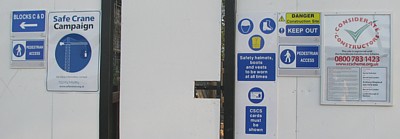




Here’s another post on the same subject which your post reminded me of:
http://meteuphoric.wordpress.com/2011/03/21/dont-warn-vaguely/
I tend to think that the net-effect of non-specific warning signs is ambiguous and might actually be counterproductive in some cases because the people who’re most likely to do whatever it is you’d like to stop people from doing are if anything more – not less – likely to do the stupid thing if there’s a sign saying they’re not allowed to do it (and everybody else just ignore the signs anyway). Warning signs sometimes expand the choice set of the target group by drawing attention to actions which they’d not otherwise have thought about doing. One example: i) couple of drunk guys walk by sign: ‘Swimming not allowed here’, ii) they hadn’t thought about it but after reading the sign they figure, hey, why not take a swim here? iii) One of the drunk guys drowns. Another version is the combination of children and pictures of actions you’re advised not to do.
And of course, someone died whilst swimming in the Thames “to cool off” only last week… wonder if there were any warning signs where he went into the water.
I think a sign calling your attention to the existence of signs (such as the one Brian admired for its sincerity)essentially does is some seriously next level shit in the world of paternalistic signage however noble the intent may have been.
I always told my son that if he ever drowns, I’ll never let him swim again. It worked so far.
How many of those drownings involved drunken idiots?
Time was when you didn’t have to worry too much about people swimming in the docks – the vapour pressure of the stench emanating from the water was enough to push back even the most drunken fool. Glad to hear that the water quality has improved.
I can rember watching the last hydraulic mains from the London Hydraulic Power Company being torn out at St Katherine’s Dock, together with the footings for Bramah’s hydraulic devils. I’ll bet they regret doing that now. I hope that the revival of Docklands doesn’t get too entirely chi-chi, and that they can keep some of the industrial history.
llater,
llamas
I compulsively read everything around me, so I always end up reading those sorts of signs. Most of them warn about things that are, intuitively, either so stupidly and obviously dangerous that they’re unnecessary (“do not sleep on train tracks”, which I think I actually saw once) or not really dangerous, but inconvenient or otherwise forbidden (“no smoking”, “no fishing”). It’s a rare occurrence indeed that one seems to actually be warning you about a nontrivial and nonobvious danger.
But you do know that according to the horse bolts, door slams theory of life, the universe and most everything else that ‘Do Not Sleep on the Train Tracks’ didn’t go up until after the remains were cleaned up, at least once?
I mean, what well dug-in safety bureaucrat would incur the expense of signage prior to the event? Can’t have that sort of expensive forward thinking round these parts.
In a libertarian society, there’d still be plenty of no fishing signs. Being able to control who can fish in your waters falls under property rights. The signs work like fences, making clear the boundaries of the area where the landowner allows free fishing.
The other type of ‘no fishing’ sign I see quite often is cables overhead, which is a justifiable warning. It’d be easy for fishermen to fail to look up, and get their line tangled in the cables, which could get expensive.
No swimming, on the other hand – well the legal theory is that without the sign, you’re liable for people who decide to take a swim. That’s a matter of civil law, so could hold even in the absence of a state, but probably wouldn’t.
I have actually swum in R. Victoria Dock, naked and under the influence, in flagrant disregard of the signs, and lived to tell the tale. Probably wouldn’t do it again, though; in the cold light of day it looked deep, dark, cold and dirty…
The docks are the venue for the swim leg of the london triathlon.
They are not dangerous but as their are not many places to practice open water swimming in london I would imagine a large number of those swimmers are participators.
Does anyone ever fact-check these claims about the number of swimmers having died in a particular stretch of water in a given year, or does everyone simply assume the claim is true?